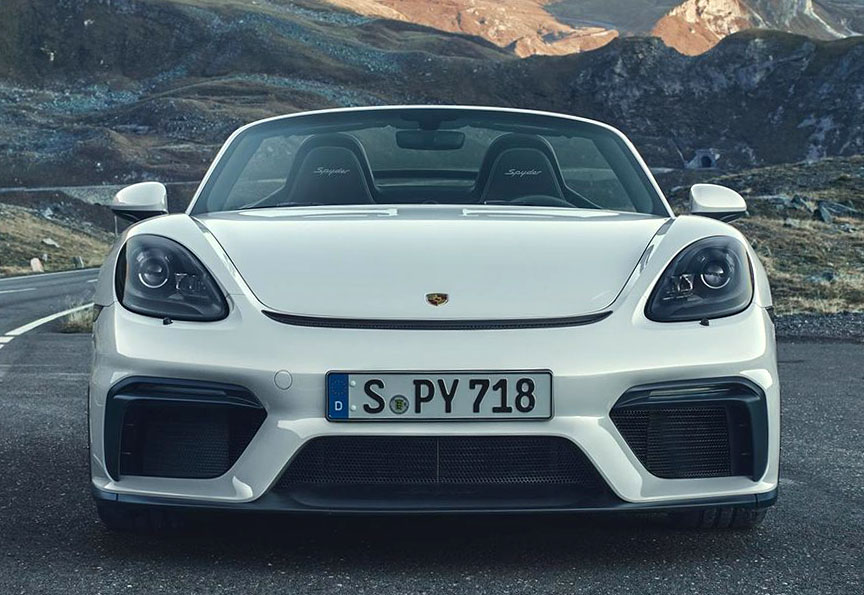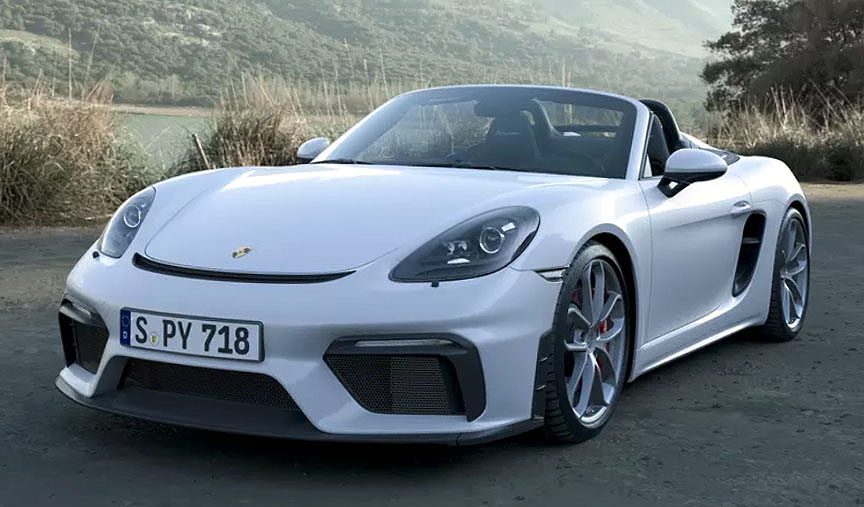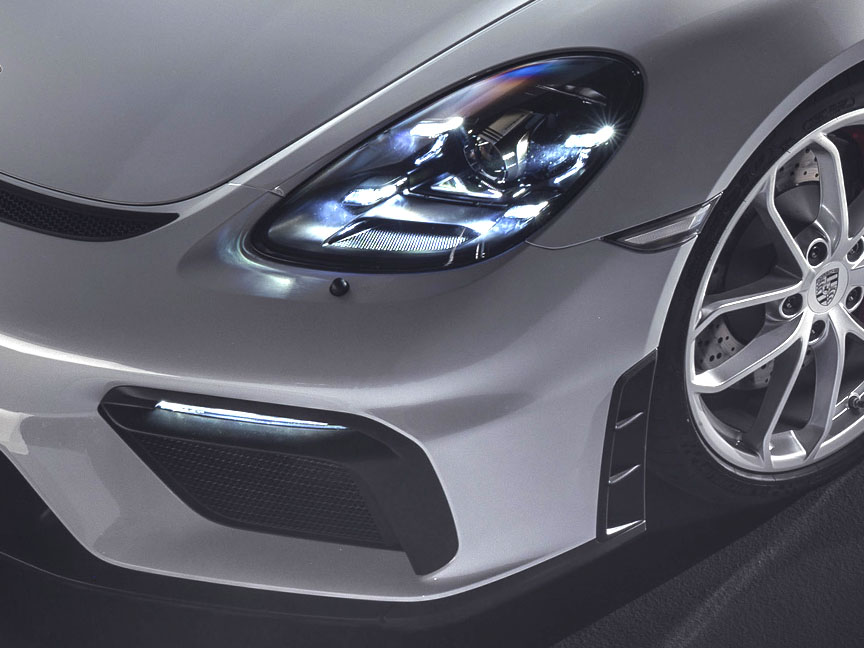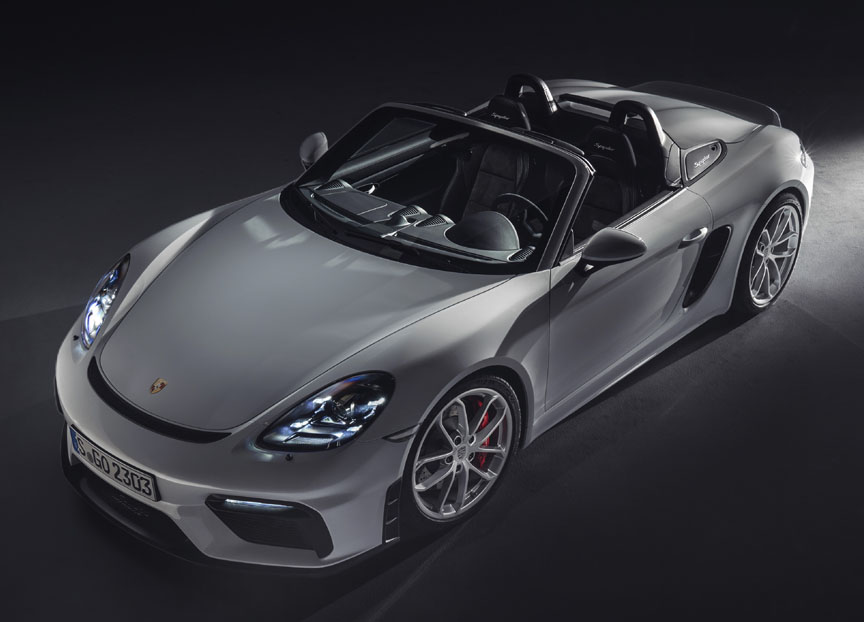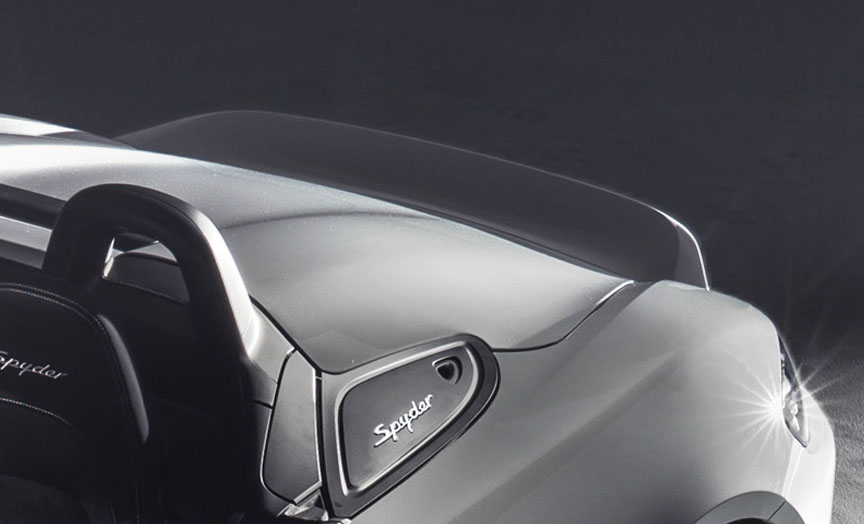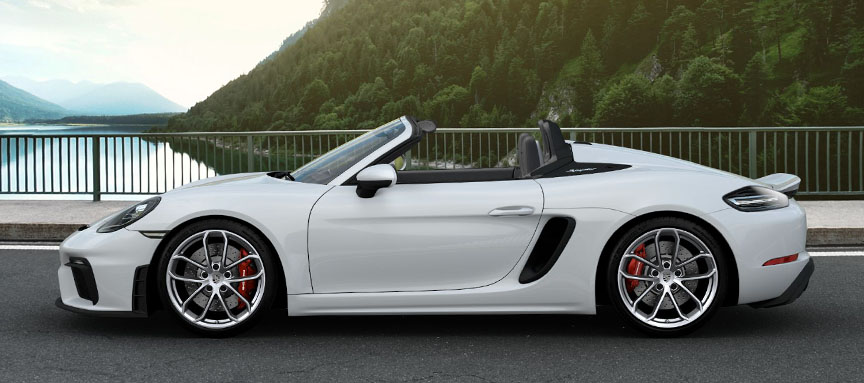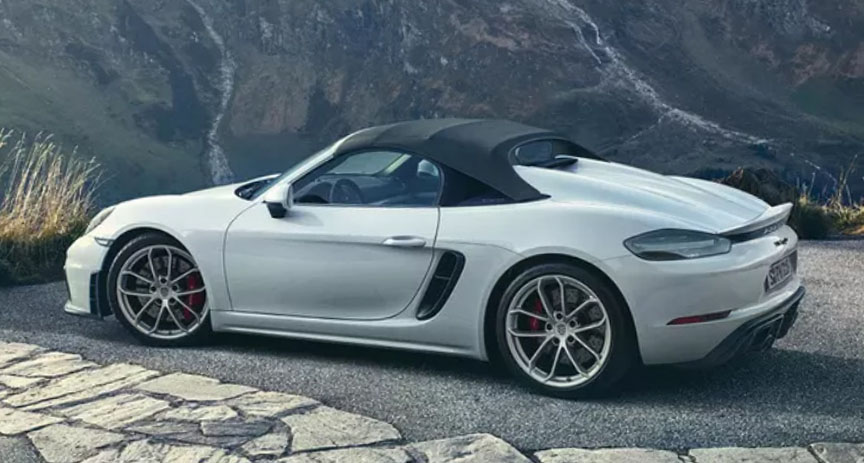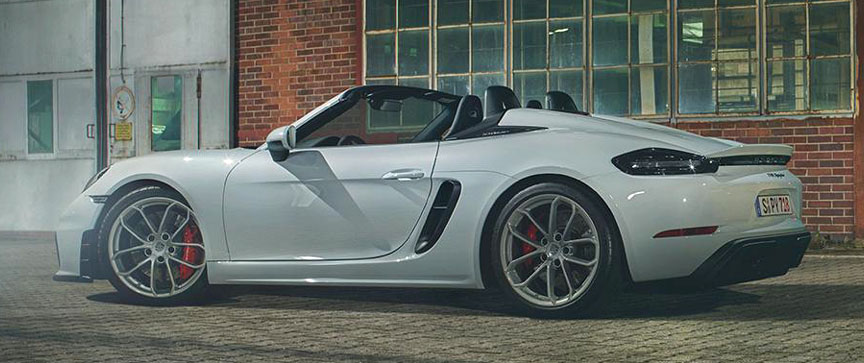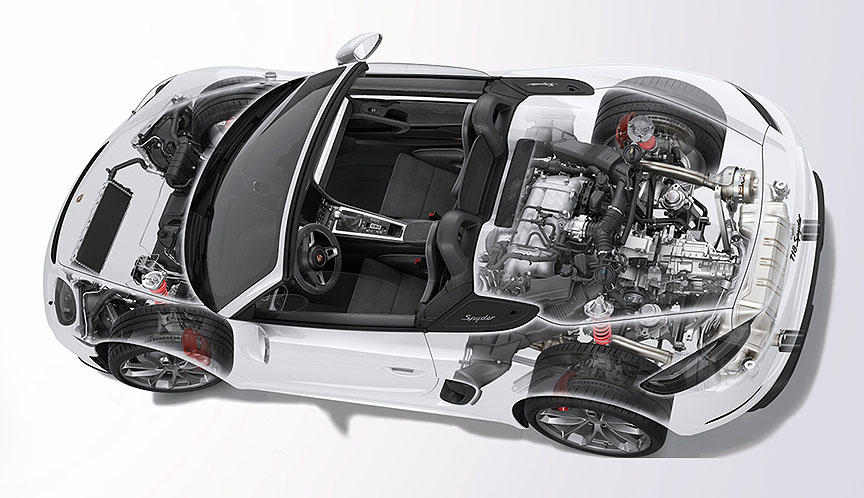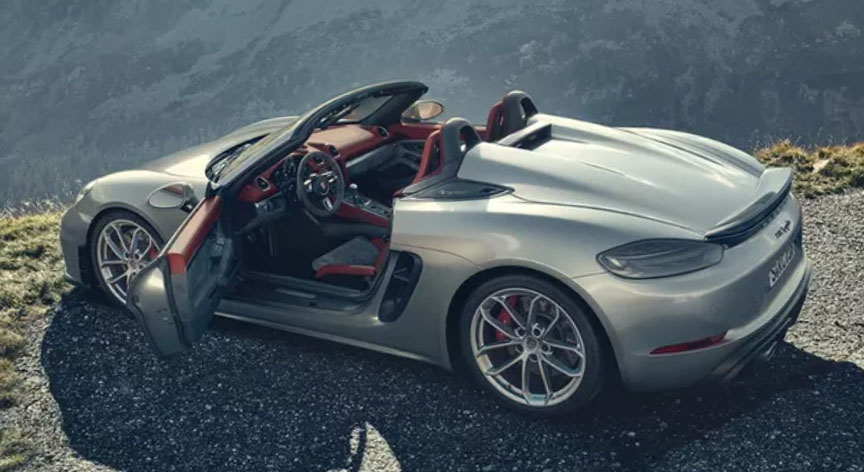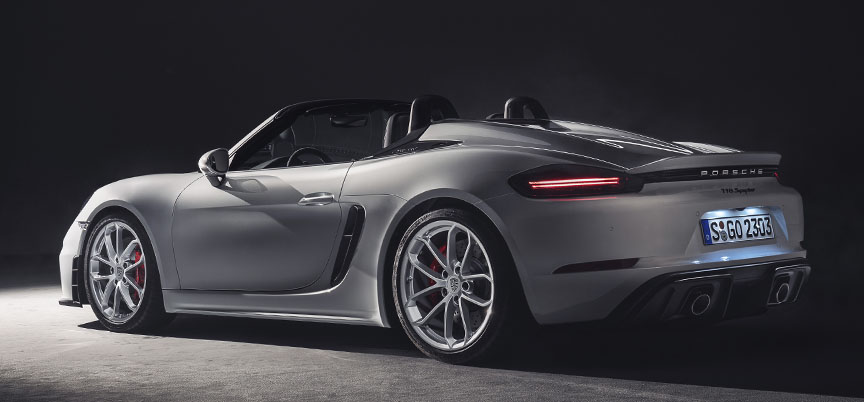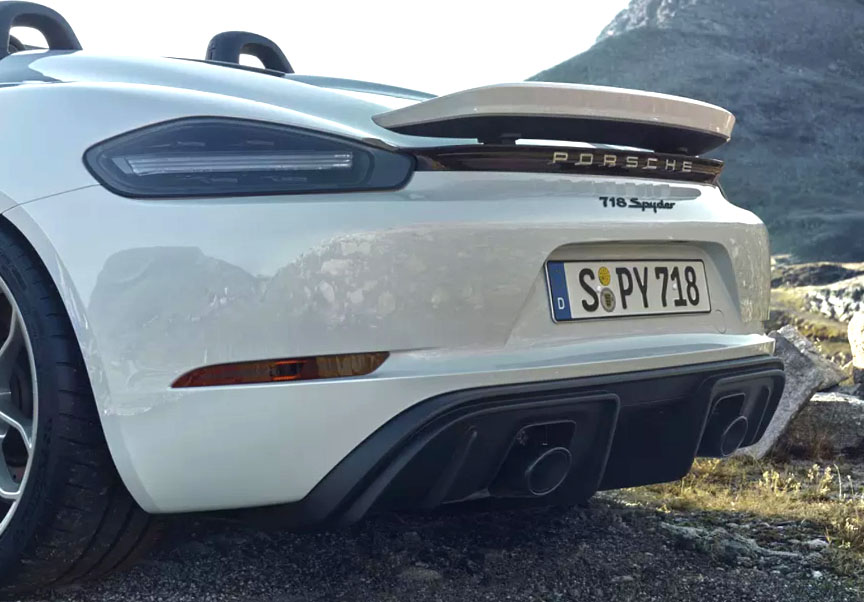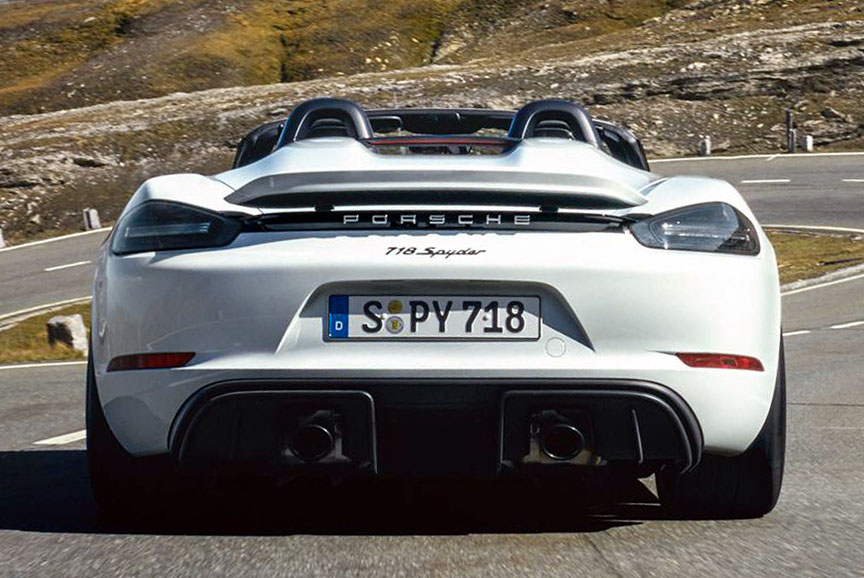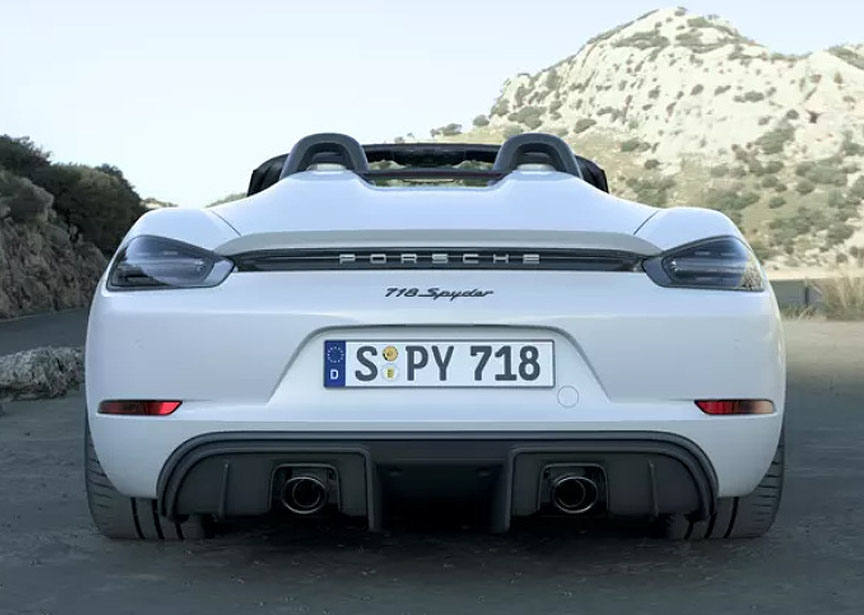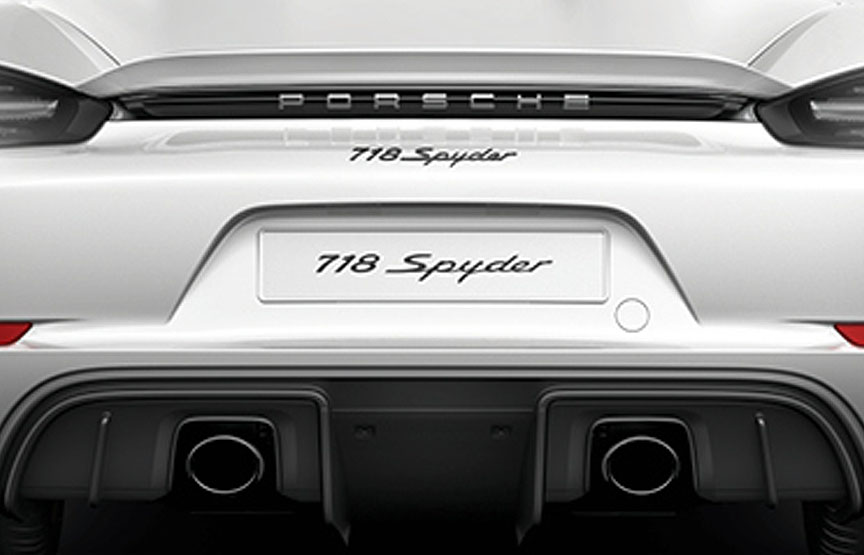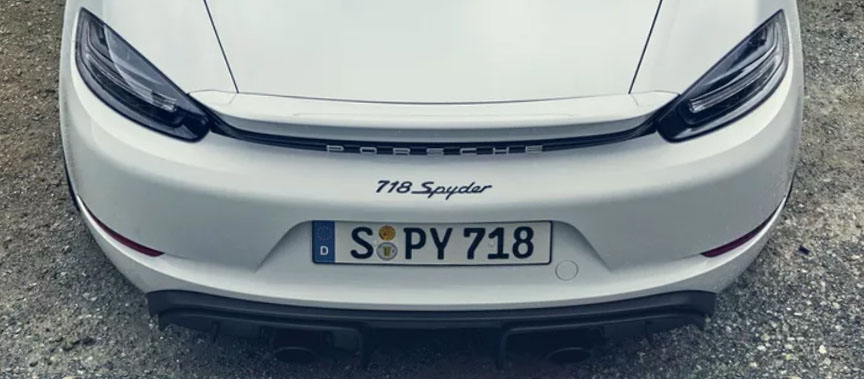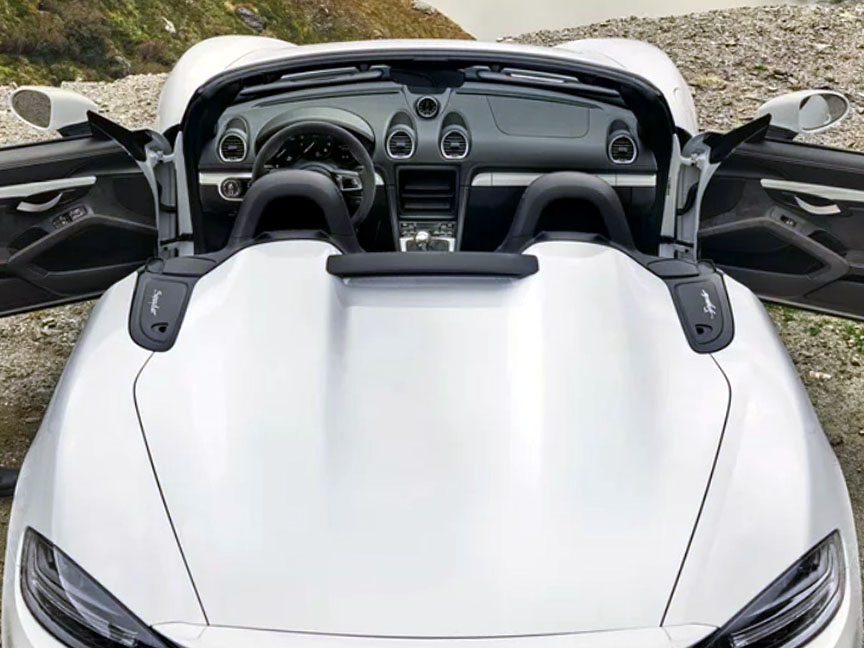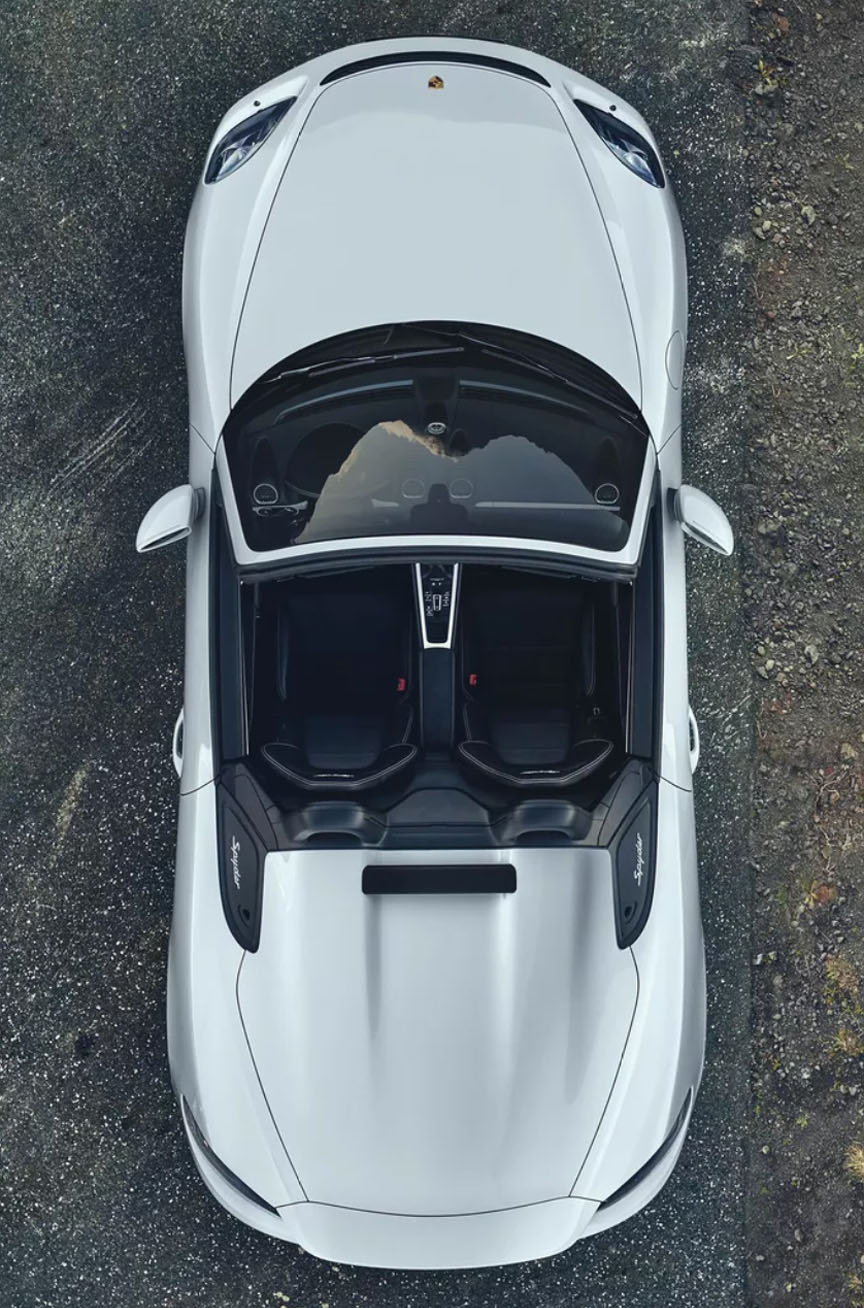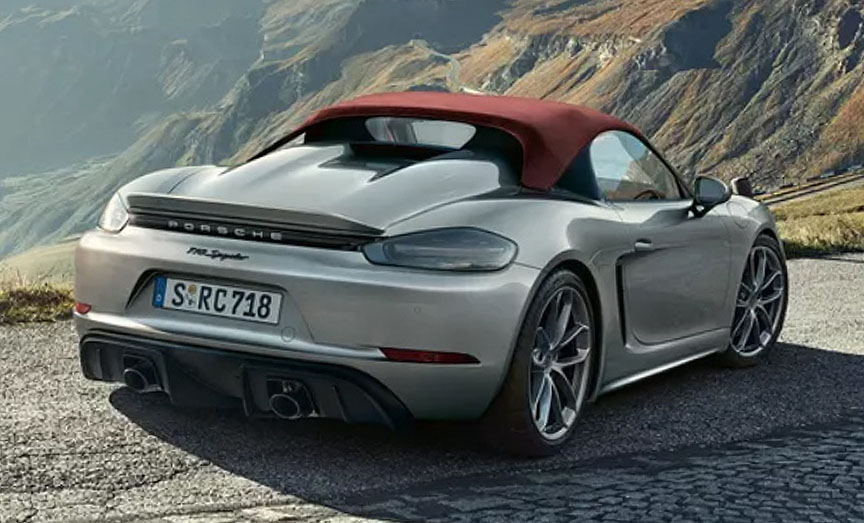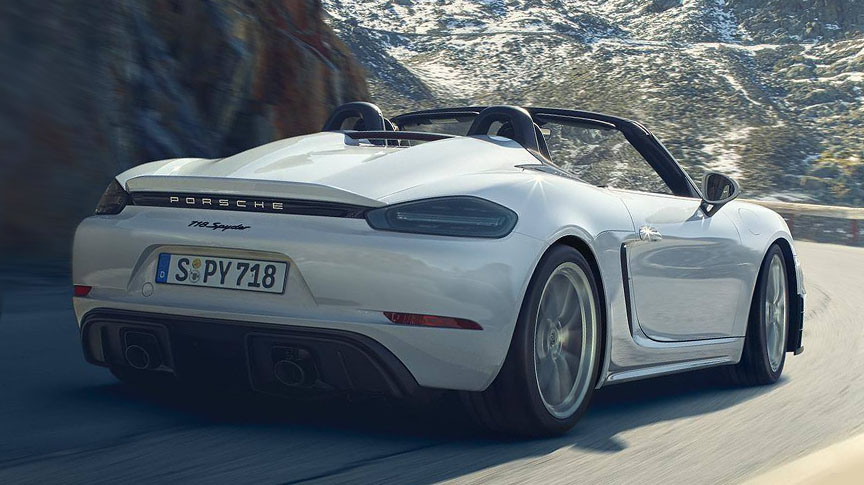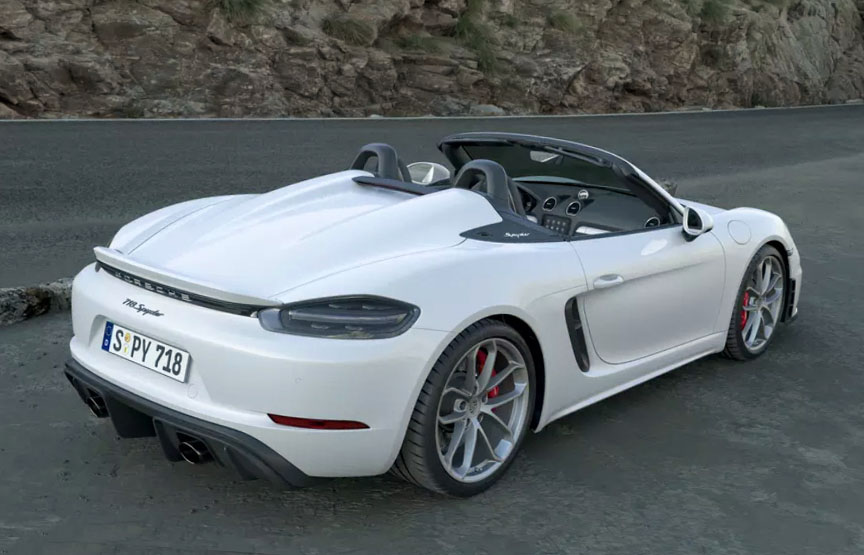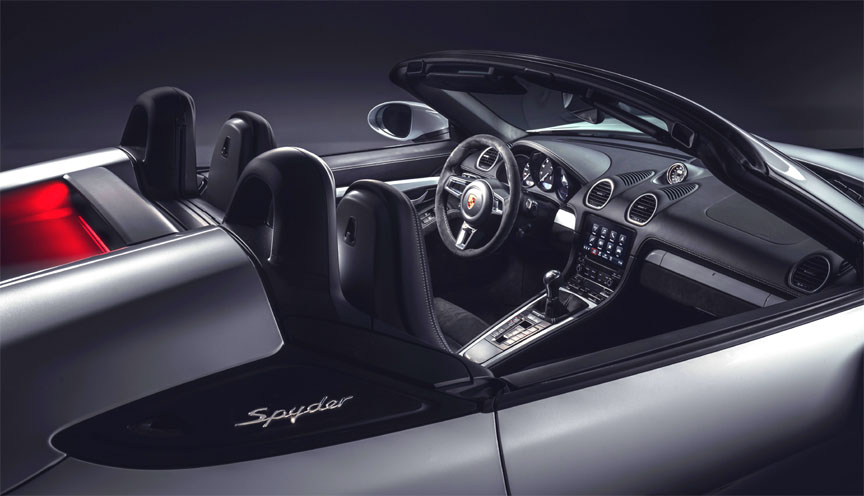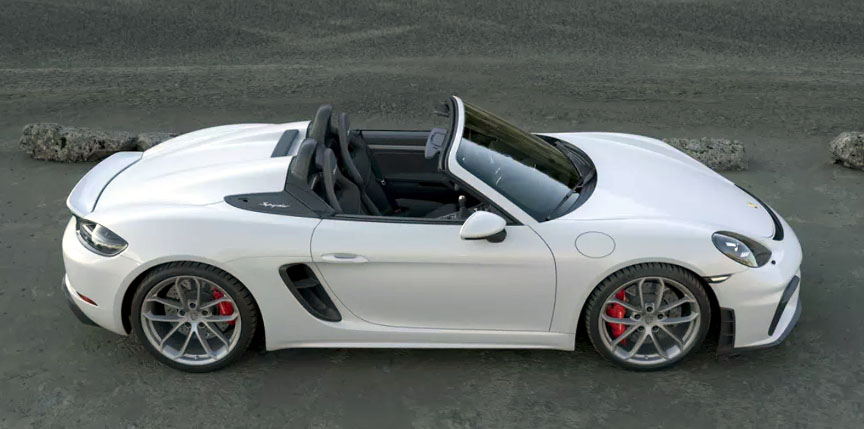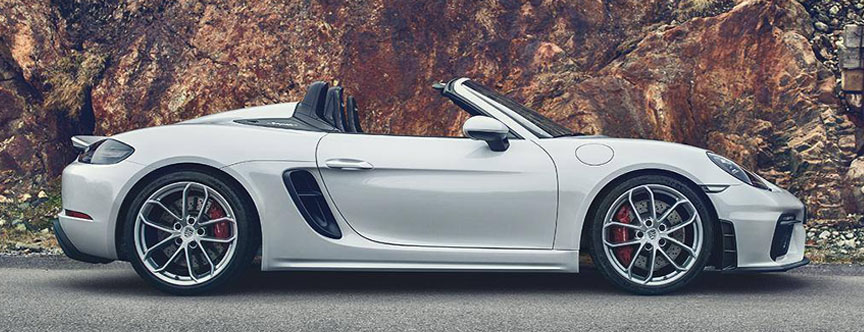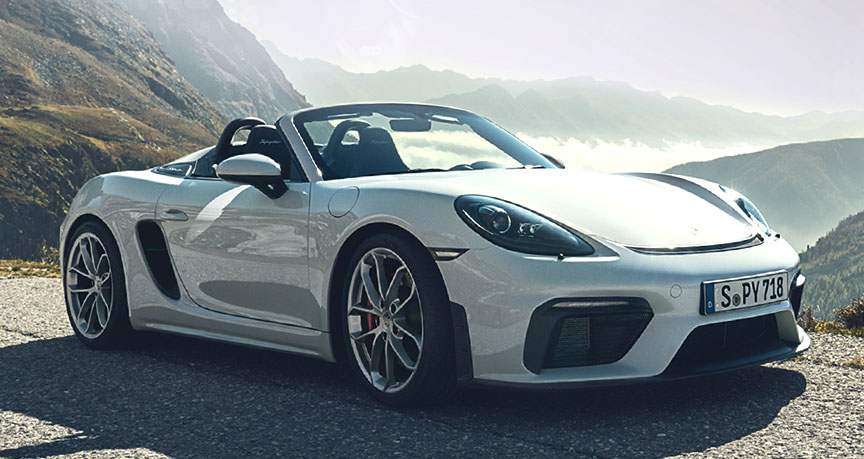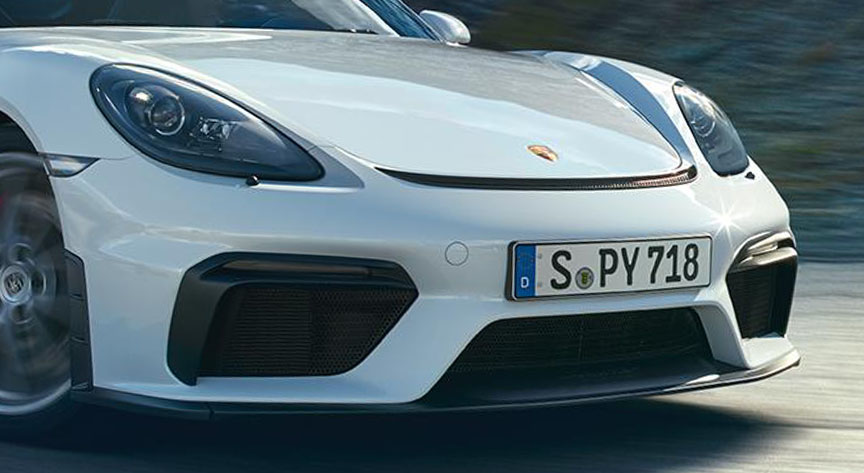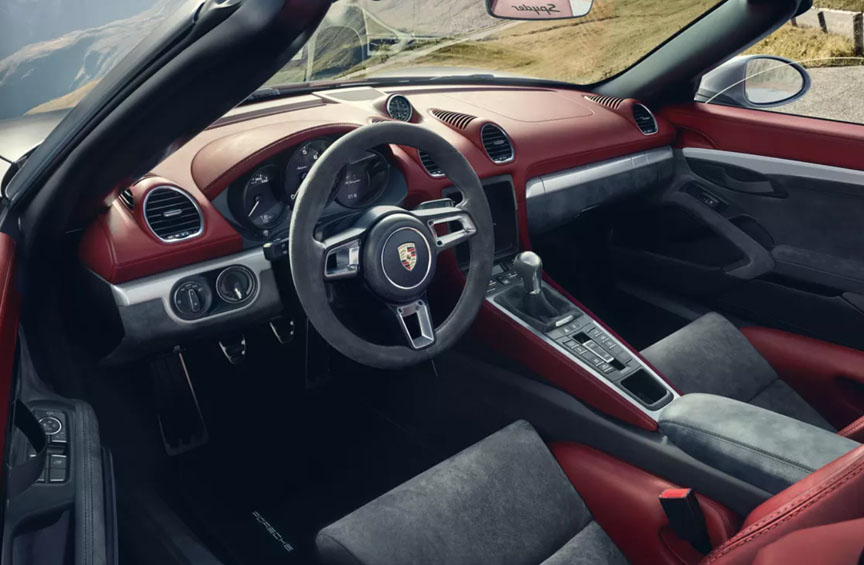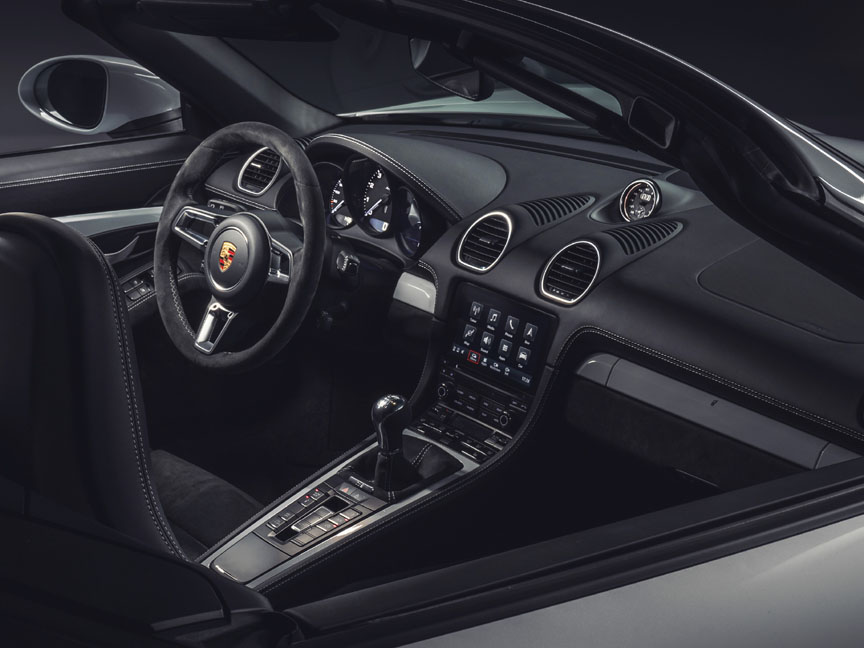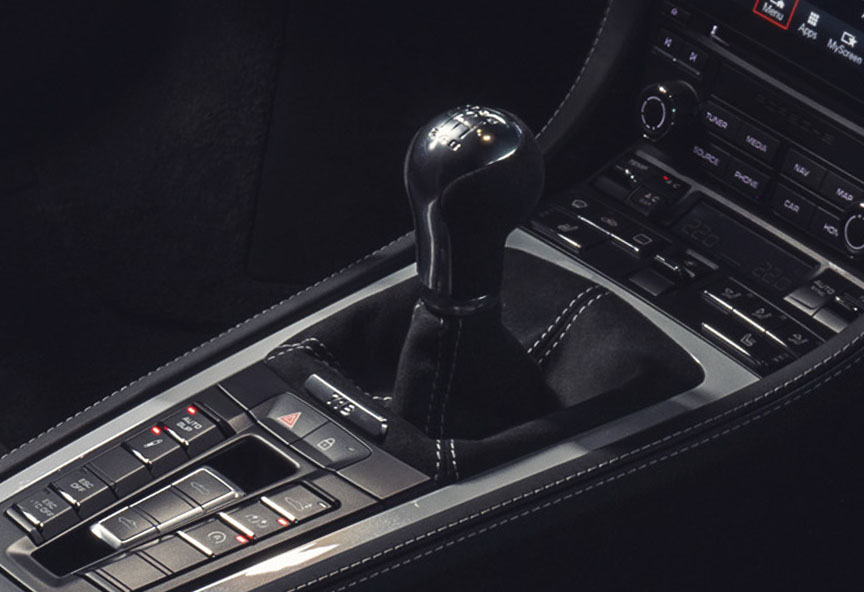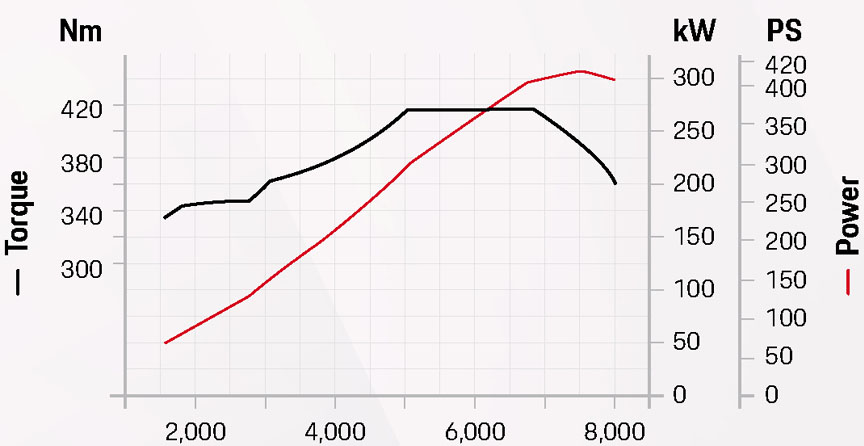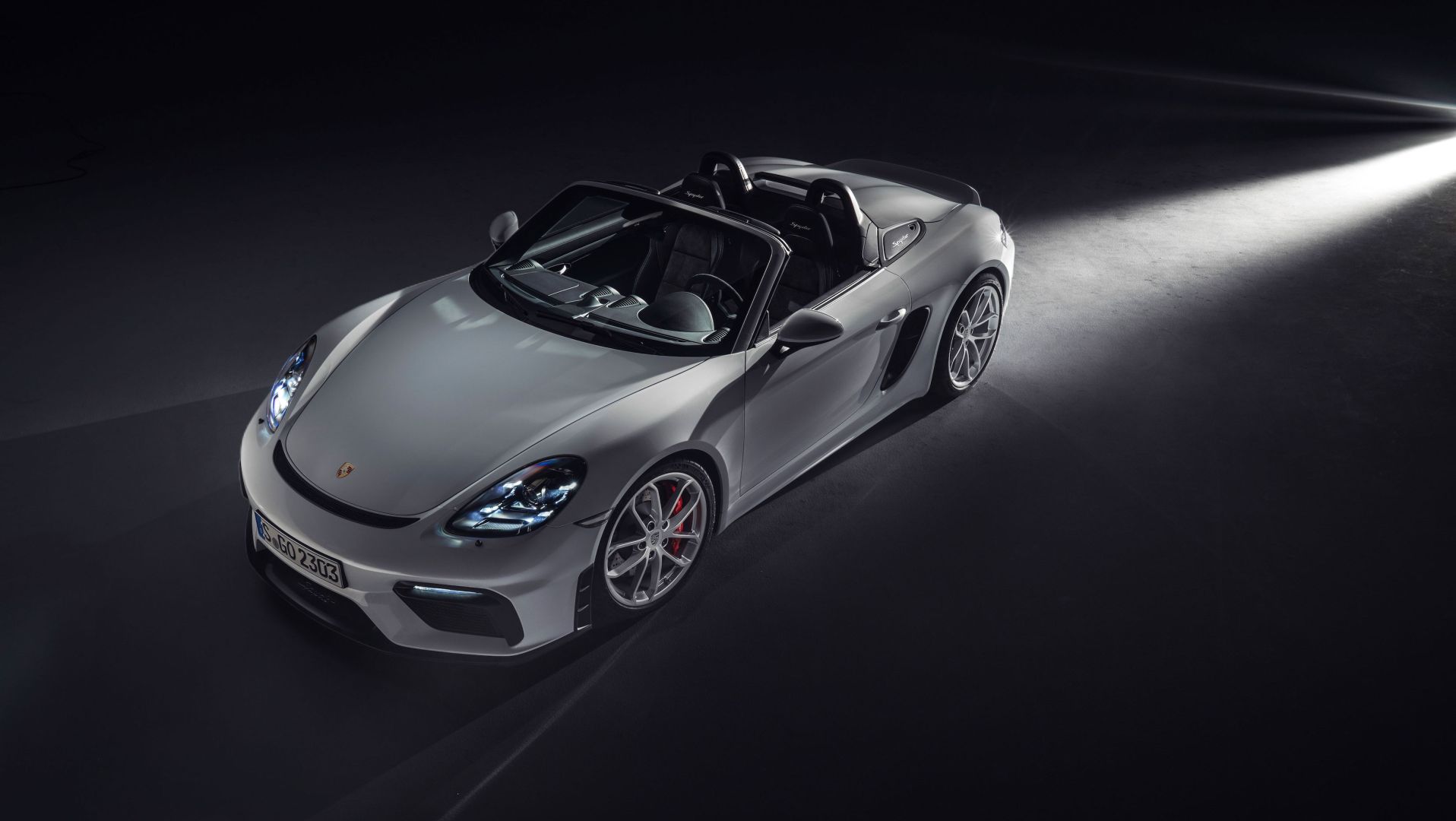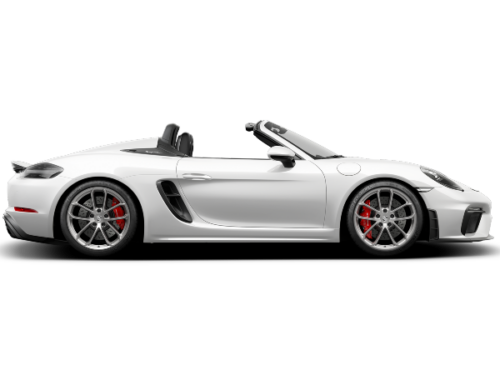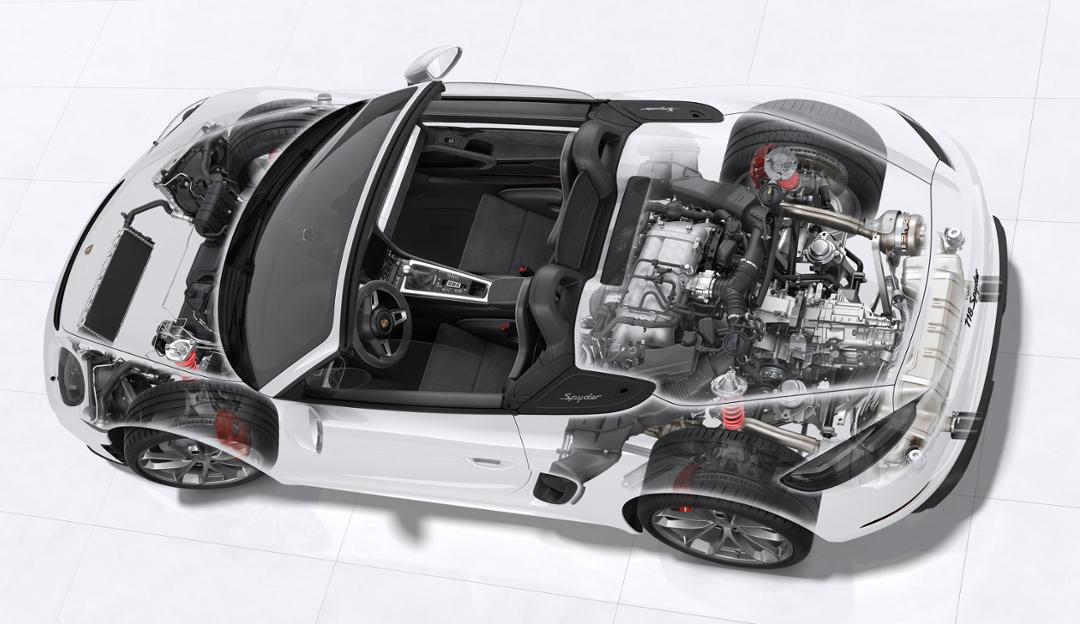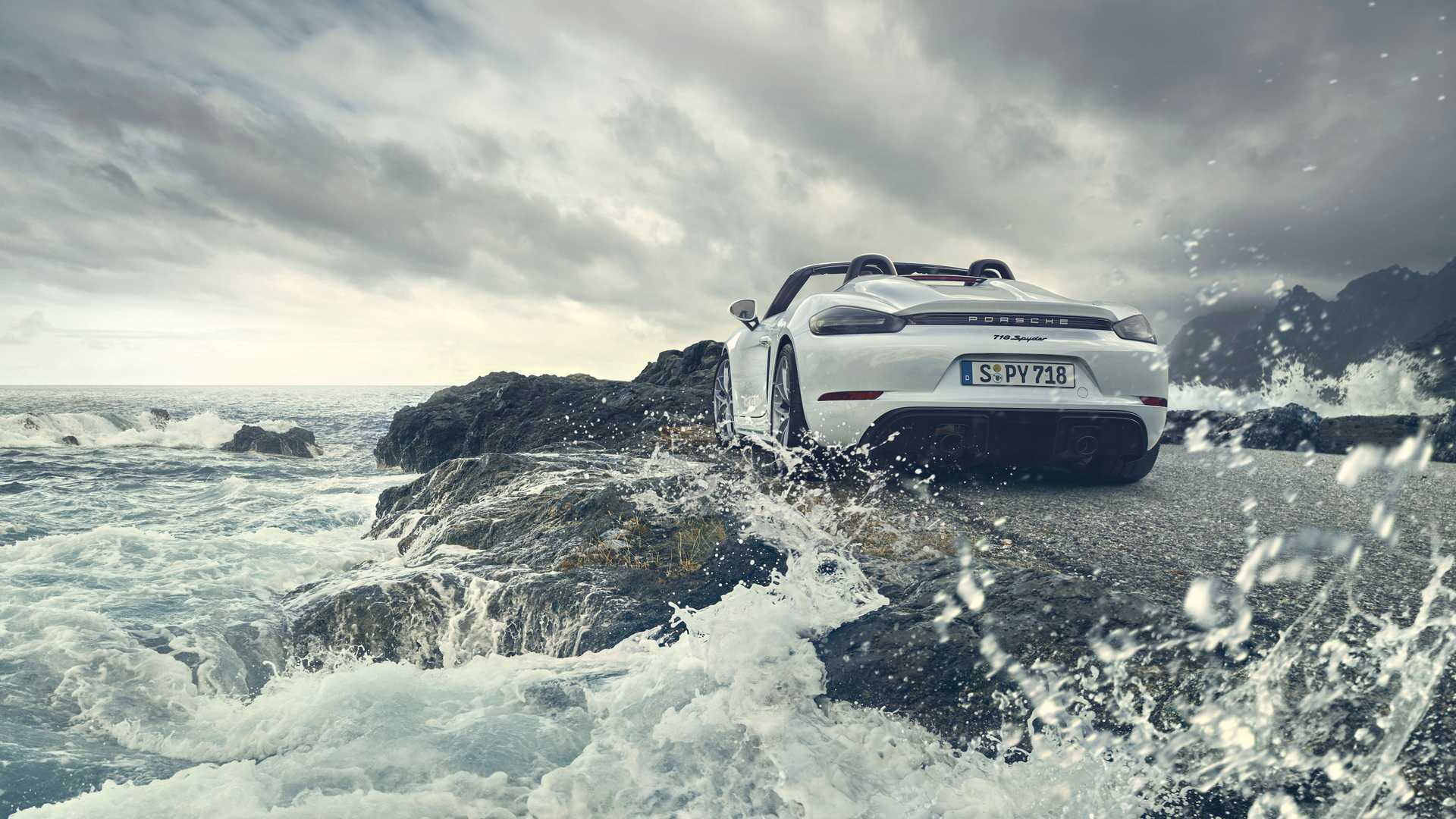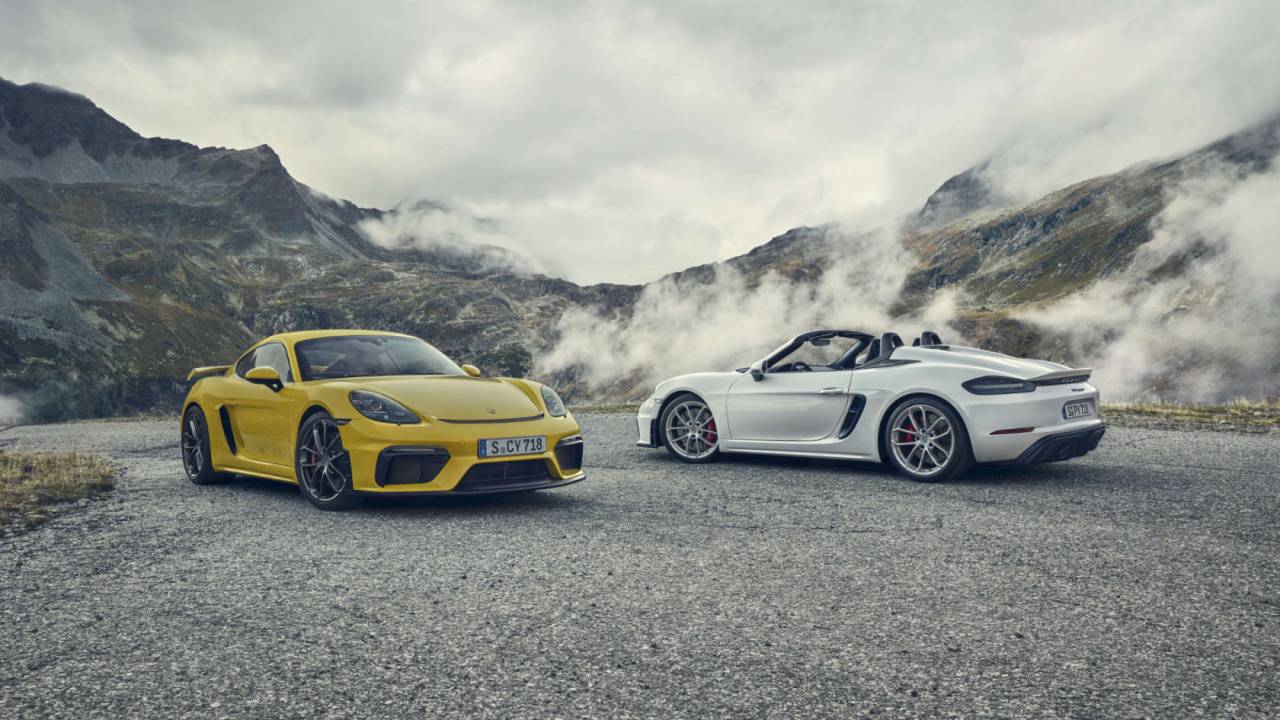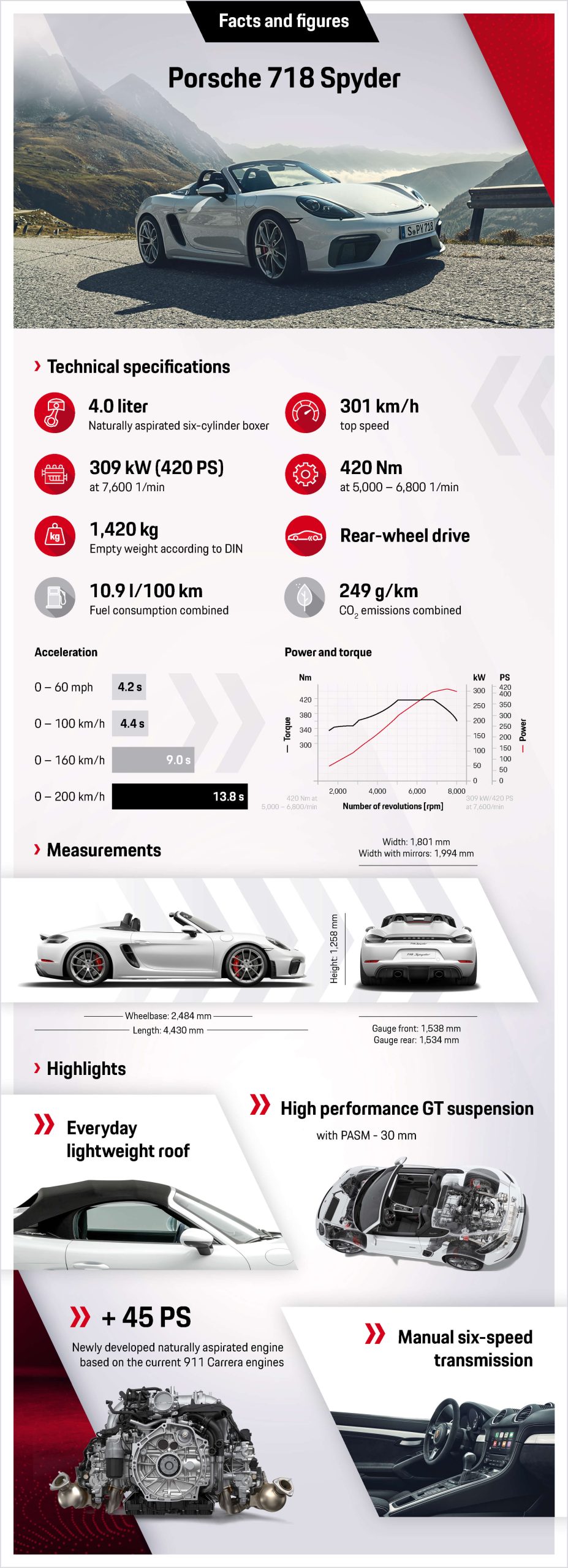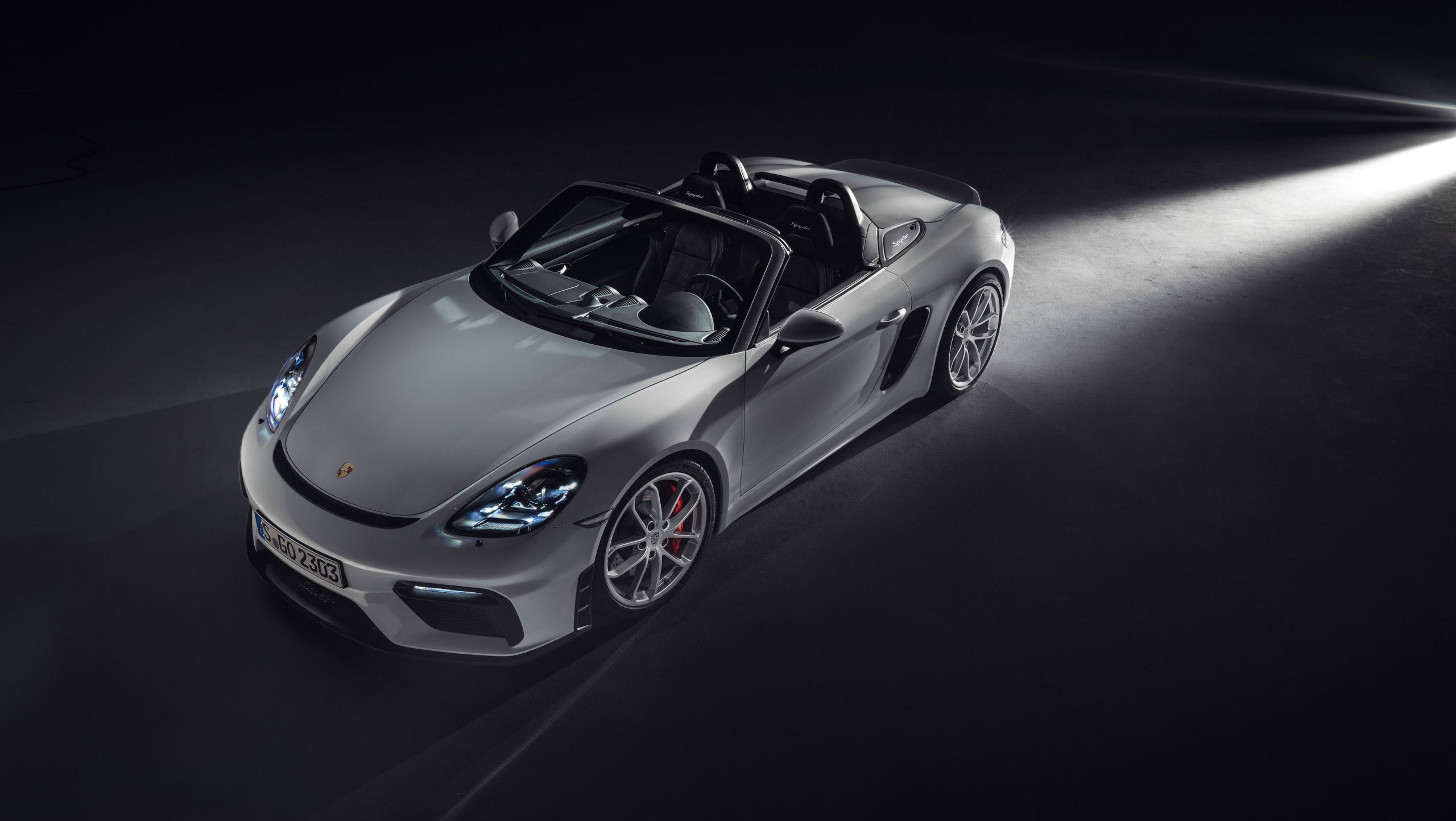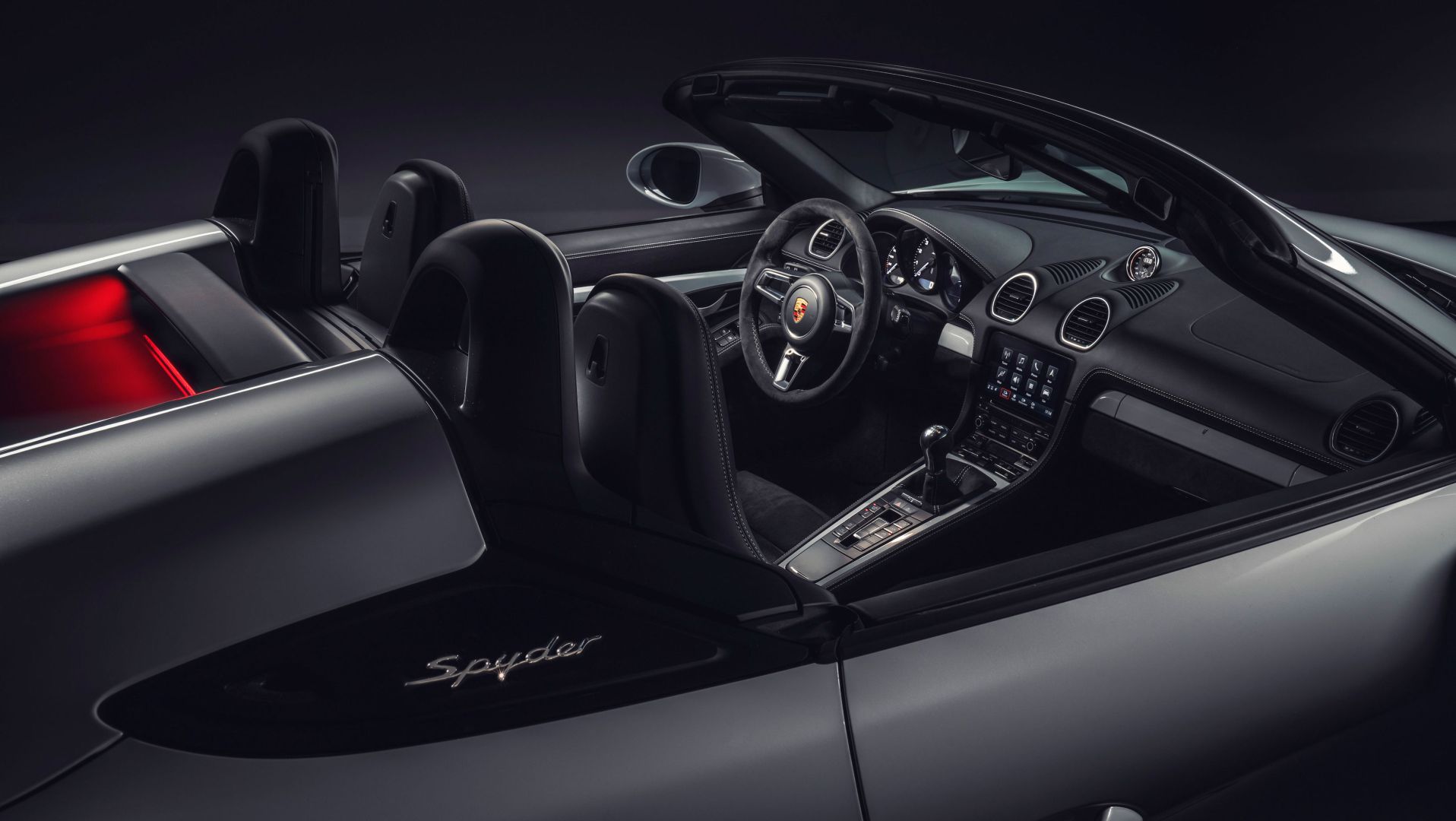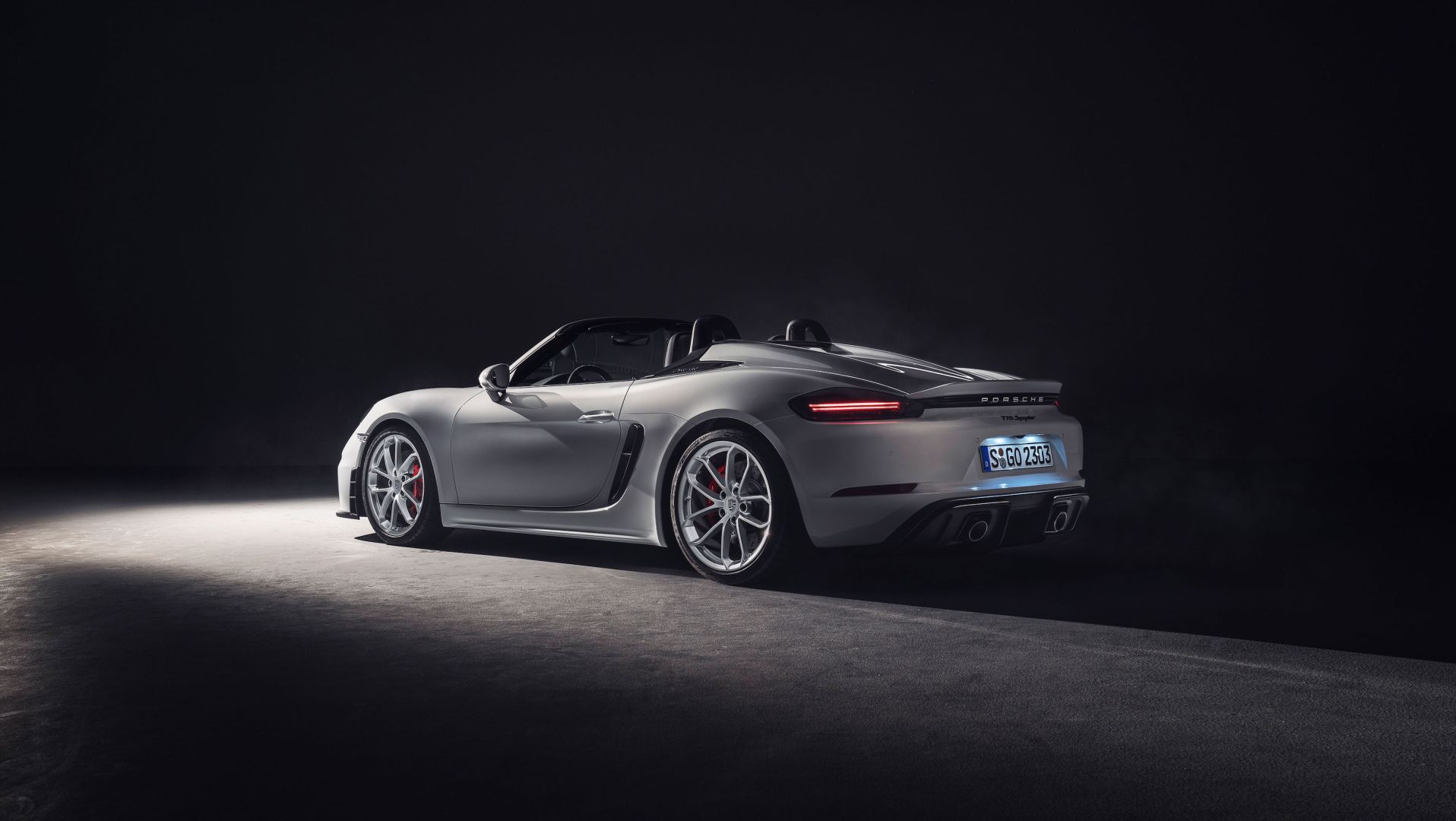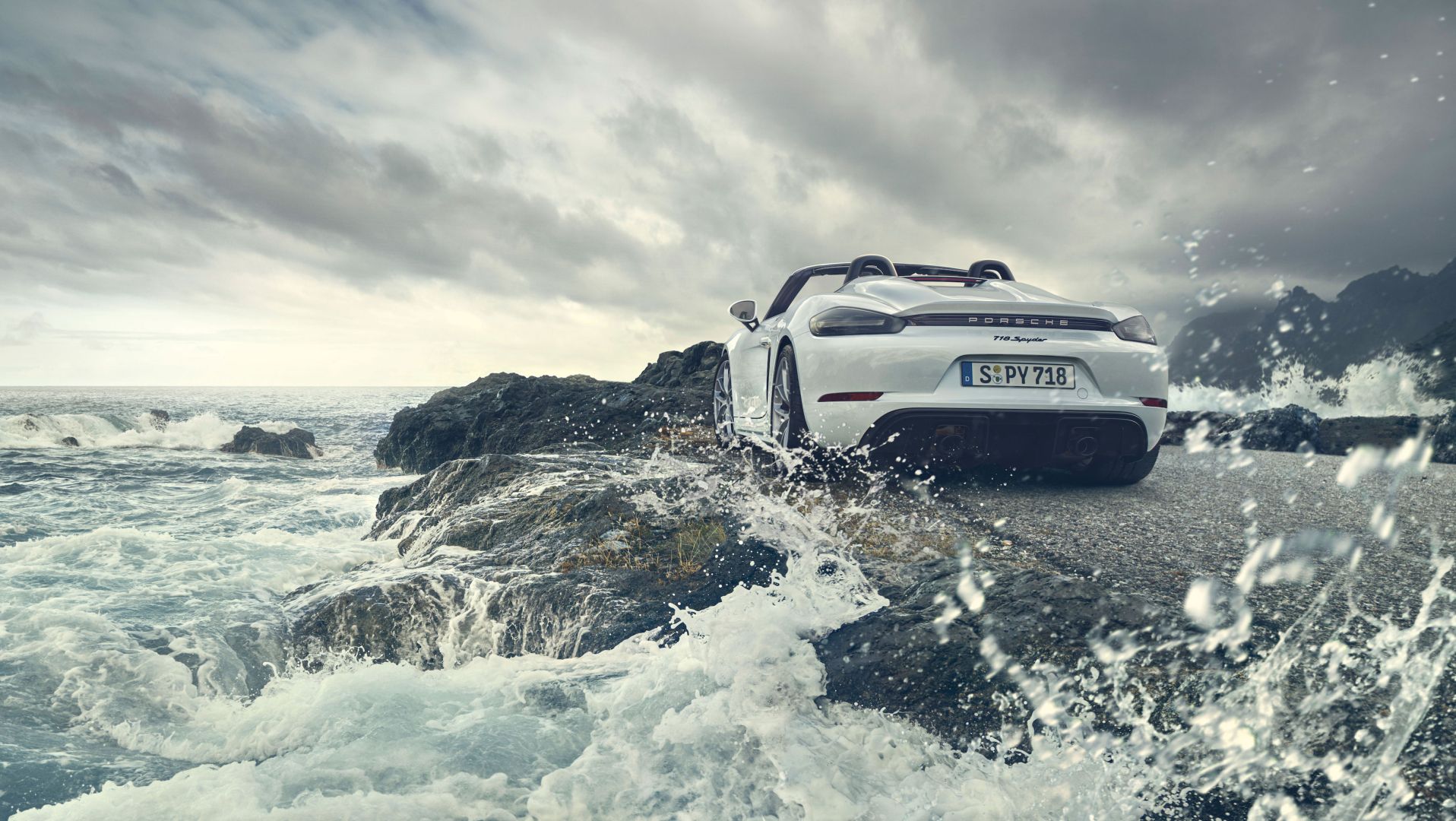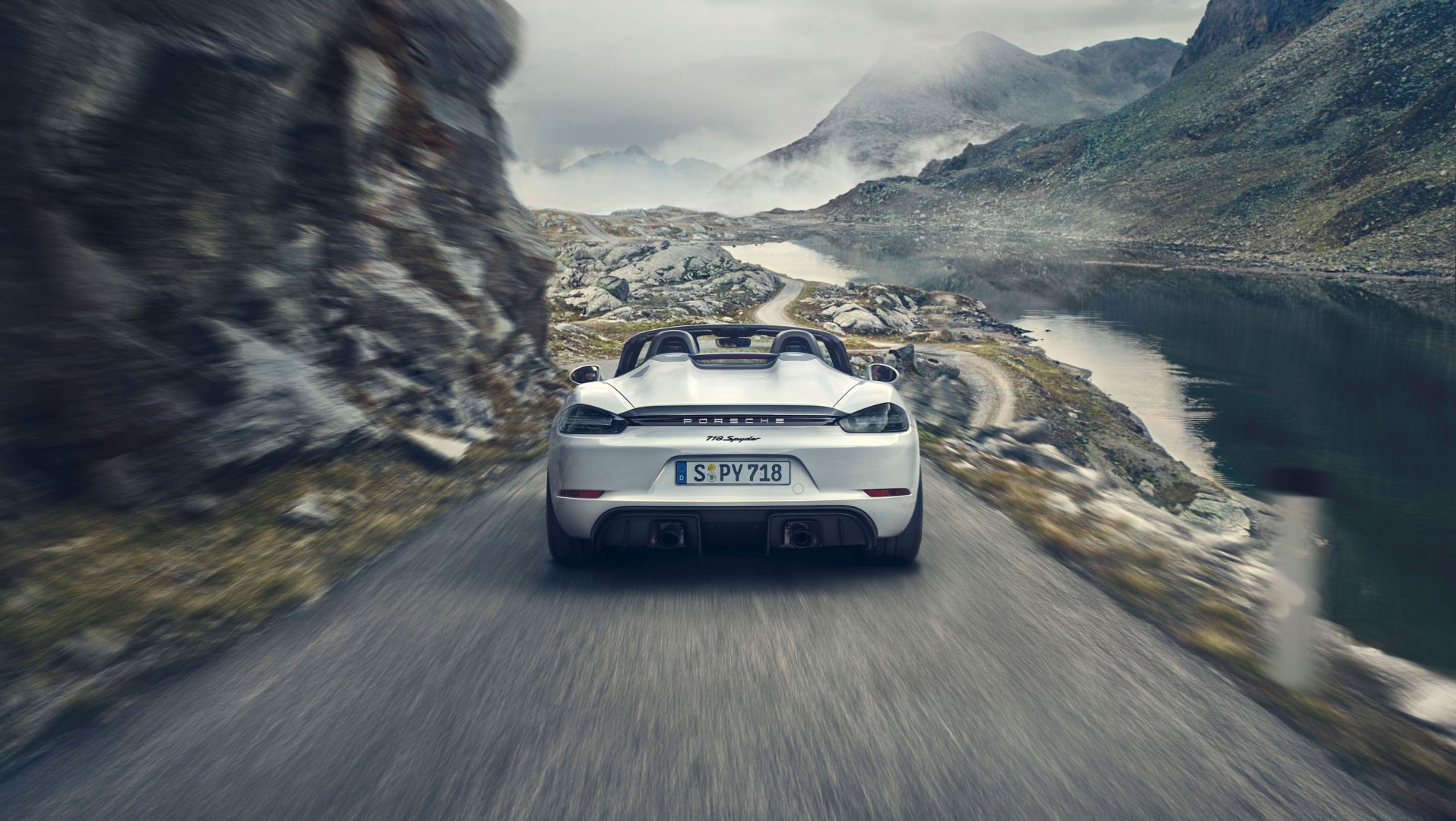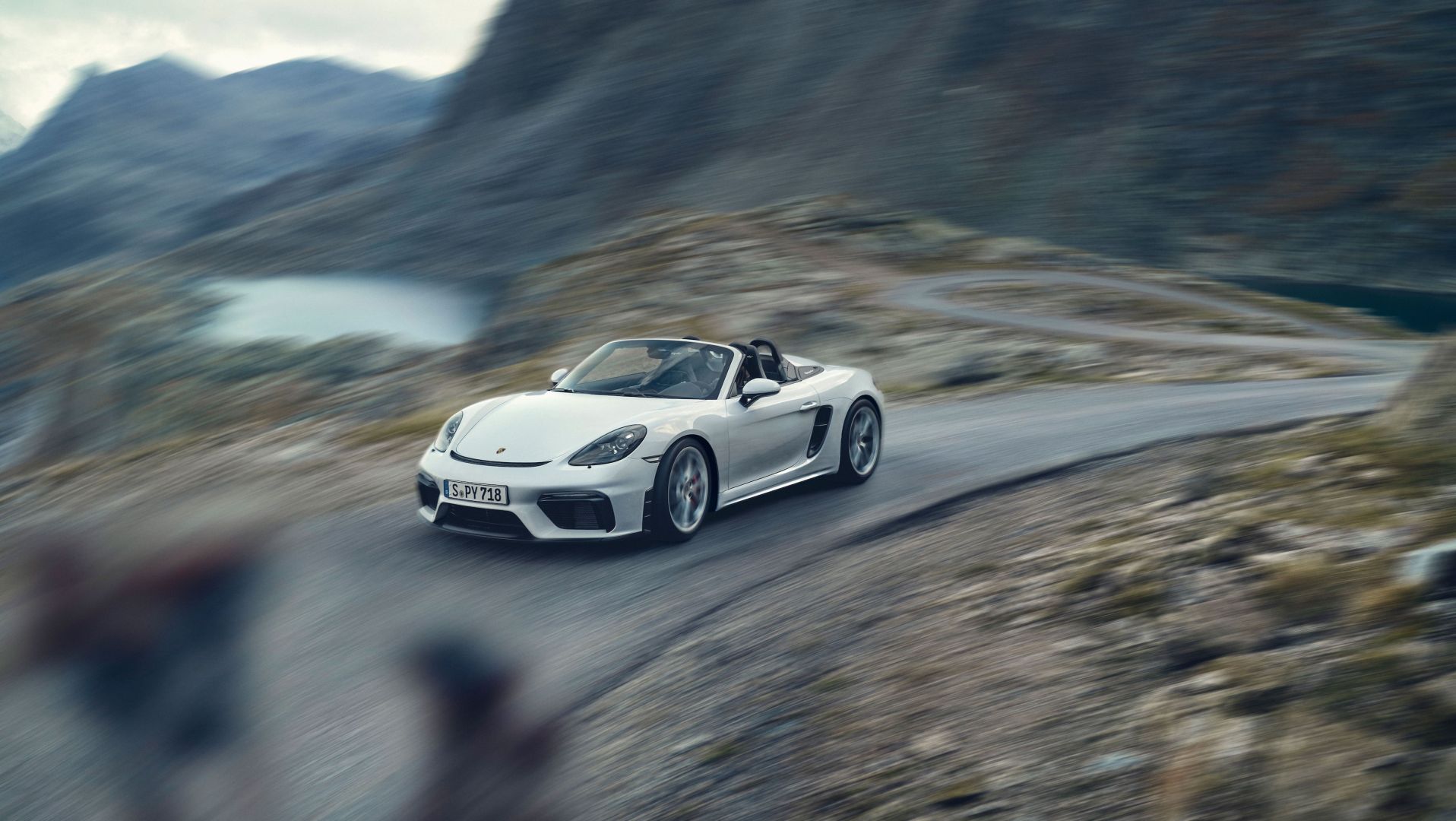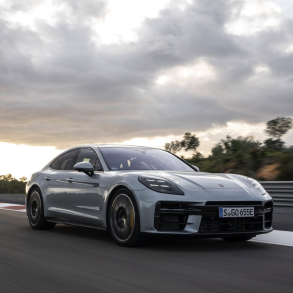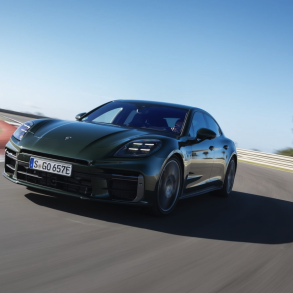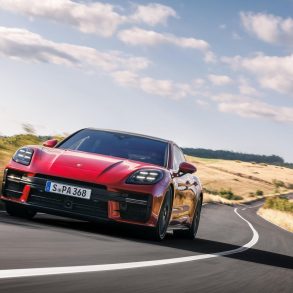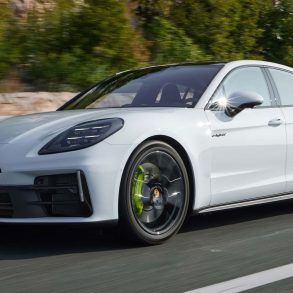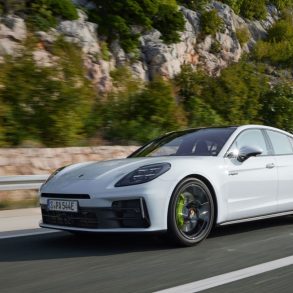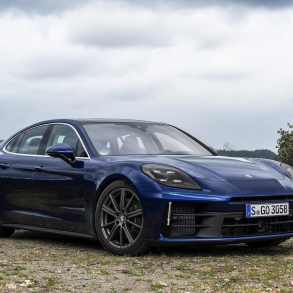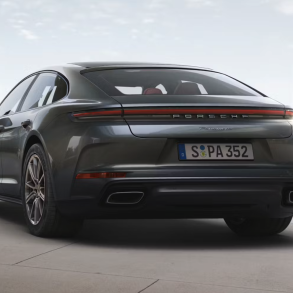Porsche 718 Boxster Spyder (2019 – 2023) – Ultimate Guide
Official photos: 2019 June 18 / Premiere: 2019 September 10, IAA Frankfurt motor show press day / Market launch: 2019 as 2020 model
The first iteration of the Porsche Cayman GT4 made its debut in 2015, drawing a conclusion to the third generation of Boxster/Cayman (981). Since that time, the GT4 has become a cult hero amongst purists with its absence of frills (not to be misheard as ‘thrills’), relative affordability and indisputable demi-god-status as one of the ultimate driver’s car. It is a Porsche model that every fan now lusts after.
For Porsche’s GT department, the blueprint used in creating the GT4 was simple – a naturally aspirated engine, 6-speed manual gearbox, and access to the 911 GT3 parts bin. Combined with the Cayman’s mid-engine layout and a signature emphasis on performance and driving dynamics, the GT4 became an instant hit.
That was then, and this is now – some things have changed, while others haven’t. Shortly after the release of the Cayman GT4, Porsche ushered in the fourth generation of Boxster/Cayman (982) in 2016. Now marketed as the Porsche 718 as a nod to the marque’s racing heritage, the new Boxster/Cayman underwent some major changes, most notably the use of a flat-4 turbocharged engine throughout its lineup.
For all intents and purposes, the 982 is mechanically and technically superior to the outgoing generation. However, the omission of the naturally aspirated flat-6 that had defined the Boxster/Cayman for so long was a hard pill to swallow for the purists, who make up much of the customer base for these cars. All in all, it was a bold step by Porsche and the decision remains inline with the brand’s overall design objectives and direction.
Amidst all of these changes. the effort that Porsche makes to be in touch with their customer base has remained as concerted as ever. As if they were eavesdropping on every conversation ever had about the 982, they have gone on to once again answer the wishes of the people with the release of the new 2019 Porsche 718 Cayman GT4 and 718 Boxster Spyder.
The most welcome fact about the new models is that they mark the reintroduction of the naturally aspirated 6-cylinder into the Cayman/Boxster series, and for the first time into the 982 generation. With the main difference between the two cars being that the GT4 is a coupe while the Spyder is a drop-top, both cars are mechanically identical and benefit equally from the typical GT-treatment we have all come to adore.
Like the inaugural GT4, the incoming ‘twins’ once again infringe on Porsche 911 territory with their stunning performance metrics to rival Stuttgart’s own flagship car. However, there is some irony in this as a Porsche GT car has never put an emphasis on padding the spec sheet, and the new GT4 and Spyder are no different.
The famed Motorsport division continues to use their cars to highlight the pinnacle of vehicle driving dynamics and enjoyment, so it’s safe to say that we are in for one hell (or two hells?) of a ride.
Engine & Performance
Specifications:
- Engine Type & Size: Flat-6 4.0L Naturally Aspirated
- Horsepower: 414 hp @ 7,600 rpm
- Torque: 309 lb-ft @ 5,000 – 6,800 rpm
- Redline: 8,000 rpm
- 0-60 mph: 4.2 seconds (Manual)
Contrary to what many believed would be the case, the 4.0L power plant used in the ‘twins’ is not the same engine derived from the latest 911 (991.2) GT3 . Without knowing much more than its displacement, one could be forgiven for thinking that Porsche simply repurposed the legendary engine for this application. For armchair analysts, it would make a lot of sense and was what many were expecting.
However, things weren’t going to be so straightforward as far as fitting the relatively large unit into the mid-engine layout, and that venture would undoubtedly prove to be cost-prohibitive in terms of steering the price of the end product sufficiently clear of 911 range. Instead, the new engine is derived from the 9A2Evo twin-turbocharged 3.0L engine used in the current 911 (992) lineup.
Besides being bored from 3.0L to 4.0L and having been stripped of its turbochargers, the modified 9A2Evo retains its 8,000 rpm redline for the GT4 and Spyder. The 414-horsepower peaks @ 7,600 rpm while the maximum 309 lb-ft of torque is available @ 5,000 – 6,800 rpm.
These figures allow the GT4 and Spyder to sprint from 0-60 mph in just 4.2 seconds and 0-124 mph in 13.8 seconds with the manual transmission equipped, and reach top speeds of 188 mph and 187 mph, respectively.
With motorsport in mind, the engine also features a number of upgraded elements such as a forged steel crankshaft, a lightweight oil pan and hydraulic valves. In contrast to its race-bred nature, the GT4/Spyder is also conscientious of its own street manners, with a cylinder deactivation feature which allows the engine to run on just three cylinders while on zero or low throttle inputs to promote fuel efficiency.
With the manual transmission becoming somewhat esoteric in nature – even within the Porsche family itself – purists will be happy to know that the 6-speed manual transmission will come standard and is likely to be one of the best examples to be had on any production car.
However, there have been some reservations regarding the unusually long gear ratios, particularly in first and second gear, with the latter able to go up to 85 mph. Rumour has it that these ratios were necessary in order for the cars to pass emission regulations.
An auto-blip function will also come standard on the manual, while Porsche’s 7-speed PDK will be optional starting with 2020 models and is expected to allow the twins to accelerate marginally faster than its gated-shifting versions.
I have my doubts about whether the PDK would be able to sway most lap-time-obsessed suitors away from the more satisfying to drive, manual gearbox. Therefore, I believe that those who opt for the PDK do so because they most likely lack technical proficiency to enjoy the manual, but not vice versa.
Chassis & Handling
The chassis has also received the works from the GT department with a level of attention that can be seen and felt throughout both the GT4 and Spyder. The previous iteration of the car known as the Porsche Boxster Spyder was based on very different design principles than the incoming version. It was basically just a restyled Boxster GTS, whereas the new Boxster Spyder is inherently identical to the Cayman GT4, especially beneath the surface.
Each car borrows a variety of parts from the 911 (991.2) GT3 – these include the front axle, front/rear dampers, wishbones and trailing arms, chassis mounts and stiffer uni ball bearings. Porsche Active Suspension Management (PASM) is standard and continues to be one of the standout features of these track-oriented 718s, which allow the cars’ toe, camber, and roll bar to be adjustable with accessibility.
It is a perfect match to the variable-ratio electric power steering unit which allows the driver to point the car with incredible precision while maintaining an instinctive sensation of the cars’ outstanding grip in every situation. Sport mode will enhance these characteristics, though Normal mode will be more than sufficient in any circumstances outside of a racetrack. Speaking of racetracks, the optional Porsche Track Precision App will allow drivers to record and analyze their lap times with a cleverly appointed user-interface.
The 380 mm brake rotors with six-pot calipers in the front, and four-pot callipers in the rear, are enclosed by 20-inch alloy wheels on all four corners. Porsche Ceramic Composite Brakes (PCCB) remain an option on these latest GT cars, and is likely to be preferred by those who want (need) to benefit from the highest levels of braking performance at the circuit.
The Cayman GT4 and Boxster Spyder are both equipped with the ultra-high-performance Michelin Pilot Sport Cup 2 tires (245/35/20 front, 295/30/20 rear) which Porsche has continued to entrust to for its GT lineup.
Overall, the Cayman GT4 and Boxster Spyder both weigh in at around the 3,200 lbs mark, which equates to a 200 lbs surplus over the other 982 trims, as well as the previous generation 981 Cayman GT4.
However when encompassing all the improvements made, Andreas Preuninger – head of Porsche’s GT department – proclaims that the new GT4 (and by association, the Spyder) will be roughly 12 seconds faster around the Nürburgring Nordschleife than the 981 Cayman GT4.
Design, Styling, & Interior
Besides the glaringly obvious, the 718 Cayman GT4 and Boxster 718 Spyder share the same DNA and are both proper representatives of Porsche’s storied motorsport heritage. The only notable difference besides the Spyder having a soft top, would be the rear spoilers on each car. At a cursory glance, the GT4 looks more single-purpose for track duties, while the Spyder tackles the winding mountain roads and city landscapes with a more unassuming type of flair.
The GT4 in particular, is fitted with a massive, purpose-built rear spoiler which generates up to 268 lbs of downforce over the rear axle – 20% more downforce than last gen’s GT4 in fact, with no drag penalty. Porsche’s GT department concluded that aesthetically and functionally, a smaller retractable rear wing – which deploys above 74 mph – would suit the Spyder more appropriately than simply overlapping the use of this GT4 paraphernalia.
To balance out the aerodynamics, the Spyder has a slightly less pronounced front splitter, but the rest of the aerodynamic and aesthetic design cues are identical to the GT4. Such elements include GT-style bumpers, a new rear diffuser which increases overall downforce by 30 percent, and each car sitting 30mm lower than the other 982 trims.
While the GT4 undoubtedly benefits from improved aerodynamics, the Spyder takes home the ‘most-improved’ award – compared to a 718 Boxster GTS, the lift is reduced by 50% and the 718 Spyder is also the first Boxster from the factory to generate downforce over the rear wheels.
The GT-ness remains apparent when it comes to the interior of both cars, which aren’t shy about boasting no shortage of motorsport heritage and driver-focused elements. A 360mm GT Sport steering wheel is standard fare, as is a shorter shift knob compared to other 718 models, as well as Sport Seats Plus with raised side bolsters.
Like the other GT cars, Alcantara continues to feature heavily throughout the interior, finding itself adorning the steering wheel rim, shift knob and dashboard.
Unless specified on the order sheet to be as spartan as possible, the GT4 and Spyder come adequately appointed with comforts and conveniences. Air conditioning and Porsche Communication Management (PCM) with Sound Package Plus are standard. PCM can also be upgraded with features such as navigation, Porsche Connect and Apple CarPlay.
Other upgrades available for both cars include track-junkie-friendly Full Bucket Seats or electrically adjustable 18-way Adaptive Sport Seats Plus, and decorative stitching in red, silver, or yellow.
The Spyder will also have some exclusive options to choose from, such as the Spyder Classic Interior Package which equips the convertible with two-tone leather in Bordeaux Red and Black, extended Alcantara upholstery, GT Silver Metallic interior trim, and a new two-tone fabric top in black and red – all of which salutes Porsche’s open-top racing cars of the past.
Performance & Specifications Summary
Model & Pricing Info
| Make | Porsche |
| Model | 718 Cayman GT4 / 718 Spyder Boxster |
| Generation | 982 |
| Car type | Coupe / Convertible |
| Category | Limited Series Production Car |
| Built At | Stuttgart, Zuffenhausen, Germany |
| Introduced | 2019 |
| Base Price (USD) | $100,550 / $97,650 |
Chassis, Suspension & Powertrain
| Curb Weight | 3,199 lbs (GT4) / 3,206 lbs (Spyder) |
| Layout | Mid-engine, Rear-wheel Drive, 2-door Coupe or Convertible |
| Body / Frame | Unitary Steel & Aluminum Monocoque w/ Aluminum Hood |
| Suspension (F) | MacPherson Struts w/ Gas-Pressure Dampers, Anti-Roll Bar |
| Suspension (R) | Transverse Control Arms w/ Coil Springs over Gas-Pressure Dampers, Anti-Roll Bar |
| Brakes | 380 mm Brake Rotors w/ 6-piston calipers (front, 4-piston calipers (rear), Optional PCCB |
| Tires | Michelin Pilot Sport Cup 2 tires (245/35/20 front, 295/30/20 rear) |
| Transmission | 6-Speed Manual |
Engine, Output & Performance
| Engine | DOHC 24-valve flat-6, aluminum block & heads, direct fuel injection |
| Displacement (Liters) | 4.0L |
| Position | Mid-engined, Longitudinal |
| Aspiration | Naturally Aspirated |
| Power (hp) | 414 hp @ 7,600 rpm |
| Power (hp) / liter | 103.5 hp / liter |
| Power (hp) / weight | 0.29 hp / kg |
| Torque | 309 lb-ft @ 5,000 – 6,800 rpm |
| 0-60 mph time | 4.2 seconds |
| 0-124 mph time | 13.8 seconds |
| Top Speed | 187 mph – 188 mph |
| Fuel Economy (combined / city / highway) |
17 / 14 / 21 mpg |
Pictures
Official Press Release
Hungry for every curve and optimized for the racetrack
06/18/2019 | The 718 family welcomes new members: with the new 718 Spyder and the 718 Cayman GT4, Porsche introduces two particularly emotional and powerful top models to claim the top spot in the model series.
Their pure character will appeal to sports car enthusiasts who delight in unadulterated driving pleasure and appreciate a high level of agility and an almost intimate proximity to the center of power.
The perfectly balanced mid-engine concept offers all this. For the first time ever, the 718 Spyder and the 718 Cayman GT4 share a technical base. This includes the newly developed four-liter six-cylinder naturally aspirated engine, together with a six-speed manual transmission.
The boxer engine generates 309 kW (420 PS; fuel consumption combined 10.9 l/100 km; CO2 emissions combined 249 g/km) in both models. Whilst the GT4 represents the entry-level GT road model from Porsche, the Spyder lends itself to all kinds of curves. Both rely on highly efficient aerodynamics, a full GT chassis, and powerful brakes.
High-revving and highly emotional naturally aspirated engine
At the heart of both models is the new four-litre six-cylinder boxer engine. The naturally aspirated engine is based on the same engine family as the turbo engines in the current 911 Carrera model series. The new high-revving engine generates 309 kW (420 PS) – 35 PS more than in the GT4 predecessor models.
The third generation of the Spyder even has 45 PS more. It delivers a maximum torque of 420 newton metres at between 5,000 and 6,800 rpm. The manual transmission sports cars can both break the 300 km/h barrier: the 718 Spyder has a top speed of 301 km/h, whilst the 718 Cayman GT4 can reach 304 km/h. Both models accelerate to 100 km/h in 4.4 seconds from a standing start.
The correlated fuel consumption of the mid-engine sports cars is 10.9 l/100 km according to the New European Driving Cycle (NEDC). The fascinating character of this naturally aspirated engine combines a modern gasoline particulate filter emission control system with the linear power delivery and the immediate response of a GT engine. It has a maximum engine speed of 8,000 revolutions.
The unparalleled boxer sound remains untouched. New additions include technical highlights such as adaptive cylinder control. In part-load operation, it temporarily interrupts the injection process in one of the two cylinder banks, thus reducing fuel consumption.
Piezo injectors are used for direct fuel injection for the first time ever in a high-revving engine. They split each injection process into up to five individual injections. This supports a complete – and therefore emissions-friendly – combustion process. A variable intake system with two resonance valves ensures optimum gas exchange in the cylinders.
Aerodynamic efficiency: more downforce, the same drag
Among the striking features of the 718 Cayman GT4 is the comprehensively improved aerodynamics concept. It produces up to 50 percent more downforce, without adversely affecting drag – proof of outstanding efficiency.
The aerodynamics of both models benefit enormously from the newly designed single-chamber arch rear silencer: it creates space in the rear section for a functional diffuser, which accounts for a good 30 percent of the downforce at the rear axle in the 718 Cayman GT4.
The fixed rear wing is also marked by greater efficiency: it produces around 20 percent more downforce compared with its predecessor. This corresponds to an additional downforce of twelve kilograms at 200 km/h.
The front section, which is optimised in the GT style, maintains the aerodynamic balance with a large front spoiler lip and so-called air curtains. The latter calm the airflow along the front wheels.
Porsche 718 Spyder: an open-top road sport car with lightweight convertible top
The new 718 Spyder is a pure machine for driving pleasure with a lightweight convertible top that can cope with top speeds. It continues the history of such famous Roadsters as the Porsche 550 Spyder and the 718 RS 60 Spyder. Open or closed, it thrills with a captivating silhouette. The roof is suitable for everyday use and can be stowed away under the boot lid in just a few steps.
Unlike the GT4, the 718 Spyder has a rear spoiler that comes up automatically at 120 km/h. Thanks to the functional diffuser, it is the first model in the Boxster family to generate aerodynamic downforce at the rear axle.
High-performance GT chassis: optimised for best dynamics
For the first time ever, the 718 Spyder benefits from the high-performance GT chassis of the 718 Cayman GT4. With its superior cornering dynamics, it provides an emotional driving experience. Its further refined lightweight spring-strut front and rear axles make use of racing technologies. The direct connection to the chassis is partially by means of ball joints.
The Porsche Active Suspension Management damping system with 30 mm lower suspension lowers the centre of gravity and improves lateral dynamics potential. It is specifically designed for use on the racetrack and makes the handling characteristics of the 718 Cayman GT4 sharper. The 718 Spyder also benefits from this design.
The Porsche Stability Management (PSM) operates with even greater sensitivity and precision here but can optionally also be deactivated in two steps. Porsche Torque Vectoring (PTV) with mechanical rear differential lock further enhances the longitudinal and lateral dynamics, cornering performance and driving pleasure.
The GT4 also comes with the option of a Clubsport package. This includes a rear steel roll bar, a hand-held fire extinguisher and a six-point seatbelt on the driver’s side.
Gripping: powerful brakes, ultra-high-performance tires
The high-performance brake system in the 718 Spyder and 718 Cayman GT4 provides consistent braking that is suitable for track driving thanks to large aluminum monobloc fixed-caliper brakes. The Porsche Ceramic Composite Brake (PCCB) is also available as an option.
One new feature is that the 718 Spyder now runs on ultra-high-performance (UHP) tires specially adapted by Porsche. They are part of the overall package that makes the 718 Cayman GT4 fly on the Nürburgring “Nordschleife”: its lap time on the 20.6-kilometer classic racetrack is more than ten seconds faster than its predecessor.
The new Porsche 718 Spyder and the 718 Cayman GT4 are available to order now.
Summary
The 718 Boxster Spyder is everything you could possibly want in a sports car. The sublime combination of a legendary chassis and naturally aspirated 6-cylinder Porsche engine is accentuated by the emphasis that less is more when done right – and nobody does this better than Porsche’s GT division. Connections with these cars are visceral and emotional, an outcome mutually desired by both Porsche engineers and customers alike. They will never be considered tardy in the right hands. The Spyder is in my opinion, the best sports cars you can buy in this segment.
Porsche 718 (982) Spyder 4.0 Details
Although with 4-litre capacity, the naturally aspirated 6-cylinder engine is not from the 383 kW 991.2 GT3 RS, but based on the same engine family as the 3-litre turbo engine in the 992.1 Carrera with GPF gasoline particulate filter emission control system. The maximum engine speed is 8000 rpm. In part-load operation, the new adaptive cylinder control temporarily interrupts the injection process in one of the cylinder banks to minimize CO2 emissions. Piezo injectors are used for direct fuel injection for the first time in a high-revving engine. They split each injection process into up to five individual injections to help to reduce emissions. The 718 Spyder 4.0 comes with a newly designed rear silencer which creates space for a functional diffuser making it the first version among the earlier Boxster and later 718 Boxster cars to generate aerodynamic downforce at the rear axle.
For the first time, the 718 Spyder benefits from the Porsche GT4 high-performance chassis – it is more of a track day weapon now than a comfortable cruiser. The direct connection to the chassis is partially by means of ball joints. The suspension is 30 mm lower than on the standard 718. The car naturally comes with the mechanical differential lock and PTV Porsche Torque Vectoring. Like with the preceding 981 Spyder, the lightweight canvas top can cope with top speeds (which was not the case with the original Boxster 987 Spyder).
The 982 generation Spyder is a whopping 105 kg/231 lb heavier than the 981 Spyder was. The weight increase is compensated with the larger and more powerful engine resulting in approximately 4% better power-to-weight ratio for the newer car.
